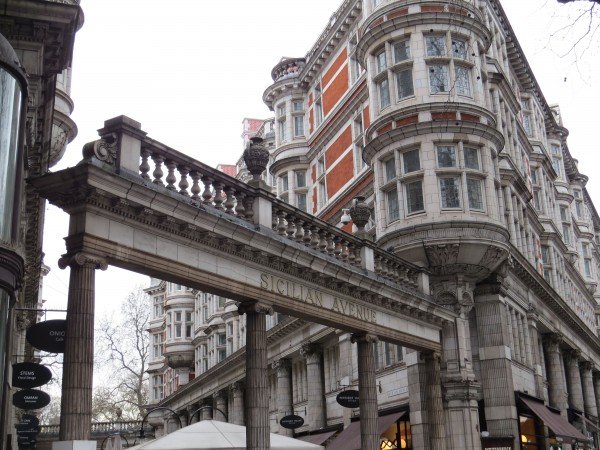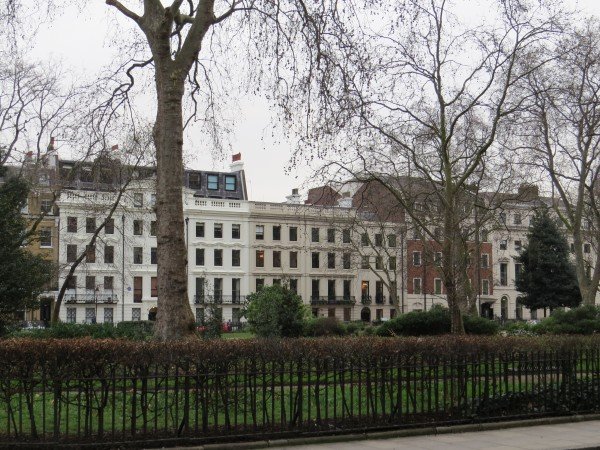Holborn Station - Southampton Row - Bloomsbury Square - Bedford Place - Russell Square - Montague Place - Bedford Square - Bloomsbury Street - Great Russell Street - Southampton Place - Holborn Station (about 1 hour)
From Holborn Underground Station, cross High Holborn and walk up Southampton Row on the west side. You can look across to some good Edwardian buildings on the opposite side of the road. On the corner, the Edwardian former Baptist Union headquarters, 1901-3, free Baroque by Arthur Keen, a pupil of Norman Shaw, with a statue of John Bunyan by Richard Garbe. Next to it, another Edwardian Renaissance gem, The Castle House by Bradshaw Gass & Hope, 1905-6. Next on the same side, the former Central St. Martins School of Art & Design, 1905-8 by the LCC Architects' Department under W.E. Riley with W. R. Lethaby, an important figure of the Arts & Crafts movement.
You are now at Sicilian Avenue, 1905-10 by R. J. Worley for the Bedford Estate, an excellent example of an Edwardian commercial development. Go in through the colonnaded screens, noting the fine shopfronts and their classical detailing.

Emerging at the far end you come to the south side of Bloomsbury Square, opposite the massive bulk of Victoria House, 1921-34 by Charles W. Long. Its grand Beaux Arts facades are strongly Greek in inspiration but it has modern steel framing. Cross the road at the lights, go into the square and continue northwards. Bloomsbury Square is the oldest London square, licensed to Lord Southampton in 1661 - Covent Garden was older but a piazza, not a true square. Bloomsbury Square was at first very simply landscaped, but was laid out by Humphrey Repton in about 1806 in more romantic manner in accordance with Regency tastes. At the north end is Westmacott's statue of Charles James Fox, gazing towards his friend the Duke of Bedford in Russell Square.

Much of Bloomsbury Square has been redeveloped, but before leaving the square, note the terraces along the north side, including, to the east, Bloomsbury Place where Sir Hans Sloane, whose collections were the nucleus of the British Museum, lived for many years. These are of the original late seventeenth century fabric but with later exteriors.
Southampton House, the seat of the Duke of Bedford, was here at the top of Bloomsbury Square, and all to the north was open countryside, before James Burton, the Bedford Estate's builder, started developing it around 1800 to cater for London's expanding population. Continue northwards up Bedford Place, solid Georgian of around that date, very characteristic of Burton's Greek Revival style. At the north end you come to Russell Square, originally developed in 1800, also by Burton. The gardens here were again by Humphrey Repton, recently restored to his design. Walking northwards through them, you can see Fitzroy Doll's exuberant Hotel Russell (1900) through the trees to the north east. There has been much redevelopment, but Burton houses remain on the south and some on the north west of the square, extended and embellished with Victorian terracotta in an attempt to update them to contemporary tastes.
Leaving the square at the north west exit, retrace your steps southwards down the west side. Here you can see Holden's towering Senate House behind yet another Burton terrace which ends with Sir John Burnet's much later Royal Institute of Chemistry building at 30 Russell Square, a well mannered addition.

Passing what is in fact a replica Georgian terrace, you come to Montague Place. Turn into it, and you will see on your left Sir John Burnet's best building, his monumental but respectful Edward VII wing of the British Museum, opened in 1914. Here you can of course also go in and inspect the fine interior.

Further on, you pass a delightful sunken garden owned by London University, as you come into sight of the splendid Bedford Square, the best preserved of all London's Georgian squares, built between 1775 and 1786, at least partly by Thomas Leverton. Go round the square, starting straight ahead along the north side, then down the west, and back along the south, noting the fine facades with their doors, fanlights, Coade Stone doorcases and tuck pointed brickwork, as well as the well planted gardens, where you would hardly guess you are just a stone's throw from the busy Tottenham Court Road.
Now turn right into Bloomsbury Street, with its similar but more modest terraces built around the same time, then left along Great Russell Street, back towards Bloomsbury Square, past the grandiose Greek Revival ranges of Robert Smirke's British Museum, the building which replaced Montague House in the 1830s and 40s, impressive in design and innovative in construction, but intrusively carved out of this intimate streetscape. Further along, just before you get back to Bloomsbury Square again, you can see an early John Nash stucco terrace of about 1777, and another Nash building characteristic of his style at the corner as you cross the road and turn into the square.

Walk south down the west side - here some of the earliest late seventeenth houses still remain, though they have been refronted. At the end, at the south west corner, note the fine eighteenth century house by Henry Flitcroft in his 'stripped' Palladian style, with its lunette window.
Turn left at Bloomsbury Way and continue south down Southampton Place, more Flitcroft of about 1760, terraced houses with Palladian doorcases and pediments. You have completed your circuit and you are back in High Holborn, and the bustle of Holborn Underground Station.
Anthony Jennings 2012